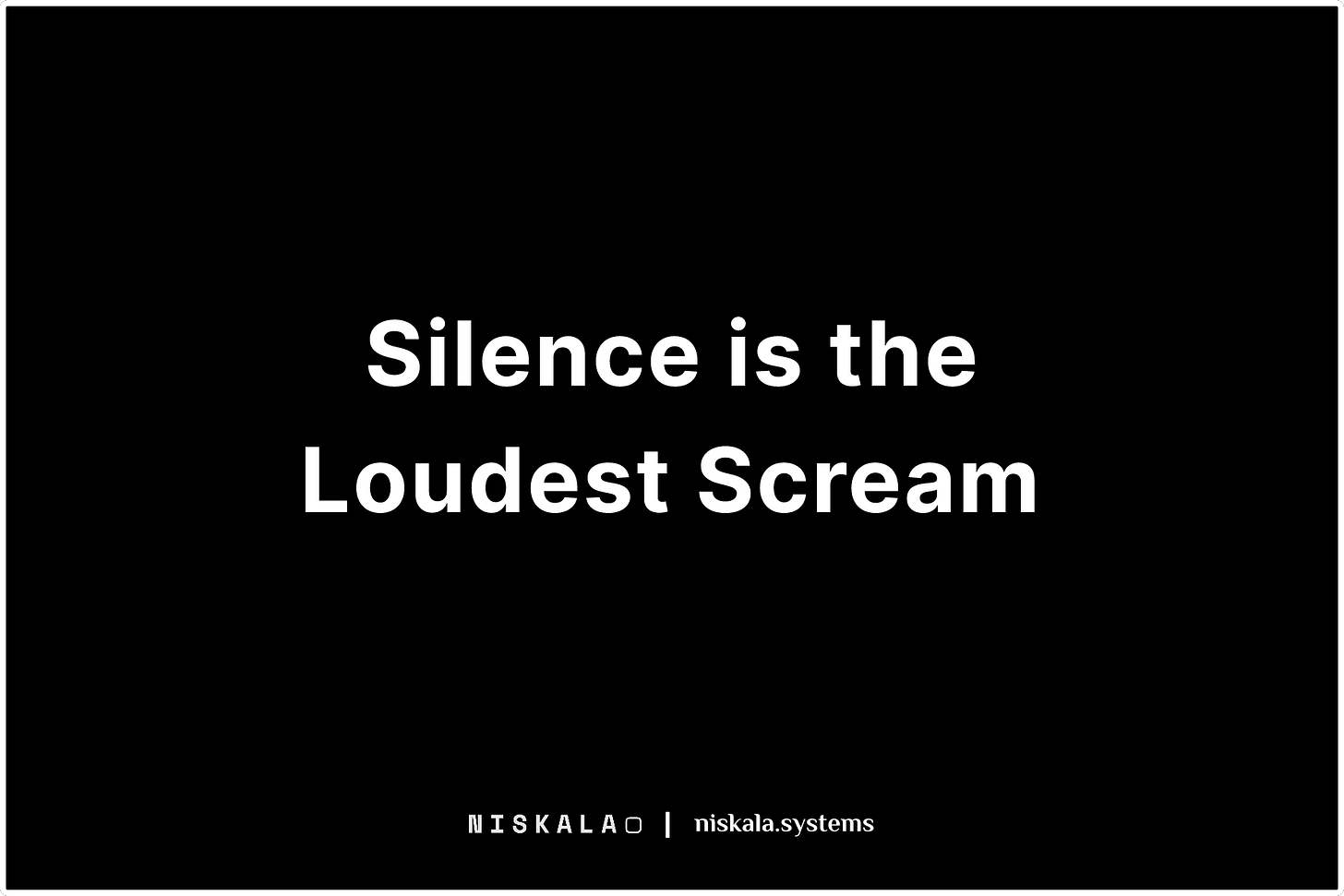Silence is the Loudest Scream
And other truths about the weapons you can't hear
Three seconds of dead air can topple governments.
A missing clause in a contract bankrupts empires.
The space between a influencer’s posts often says more than their captions.
We’re trained to chase signals — but mastery lives in reading the gaps.
Silence isn’t empty. It’s a shaped charge. When a CEO “has no comment” during a scandal, they’re not withholding speech — they’re weaponizing the public’s imagination. Your brain fills voids with worst-case scenarios, childhood traumas, cultural biases. Skilled operators don’t control narratives — they control the vacant lots where your paranoia builds condos.
This isn’t mystical. Watch any viral conspiracy theory birth itself:
The missing plane manifests a thousand shadow governments.
The unreleased medical report becomes proof of alien DNA.
We’re pattern-seeking animals drowning in data, so we turn absences into constellations. The modern mind is a Rorschach blot hung in the gallery of algorithmic feeds.
The Three Laws of Silent Influence
The Void Expansion Principle: Unexplained space grows until filled — usually with others’ agendas
Selective Muting Dynamics: What’s omitted reveals priorities more honestly than what’s stated
Echo Collapse: Prolonged silence from expected sources triggers credibility implosions
Think of Twitter’s early days — not as a town square, but as a game of Marco Polo. Accounts gained power not through tweets, but through strategic non-replies. The blue-check elite mastered letting others define their silence as profundity. Now apply this to geopolitics: When North Korea stops missile tests, analysts panic more than when they launch. The absence becomes the event.
Corporate crisis manuals now have whole chapters on “calculated muting intervals.” Tech firms let outrage cycles exhaust themselves by not feeding the beast. But this only works if the silence is designed — random quiet reads as incompetence. Patterned absence signals control.
How to Detect Engineered Silence
Start with the Japanese concept of ma — the intentional pause in music or conversation. Now scale it to media ecosystems. Healthy discourse has rhythm. Manufactured silence disrupts cadence. Watch for:
Data Voids: Topics with no authoritative sources, ripe for hijacking (search “why do vaccines…” and let autocomplete horrify you)
Chronological Gaps: Sudden drops in coverage about ongoing scandals
Mirror Omissions: When opposing sides both avoid mentioning the same fact
A real-world drill: Next time you see activists and corporations “clashing,” map what neither side discusses. That shared silence is often the actual battlefield.
For example, drug companies and anti-vaxxers both avoid discussing third-world vaccine access logistics. Why? Because it complicates their narratives. The unmentioned truth becomes a landmine no one wants to trigger.
Silence as Signal Amplification
Special forces units use “noise discipline” — the strategic suppression of sound to amplify the impact of necessary communications. Civilians can weaponize this. When everyone’s shrieking into voids, your restraint becomes a lighthouse.
The 2020 Belarus protests taught us this. As state media blared propaganda, citizens communicated through shared silence — turning off lights at specific times, leaving empty chairs in public squares. The absence spoke. Police couldn’t arrest a vacancy.
Personal application: Next negotiation, try the “three-beat pause” after any offer. Let the silence pressure the other side into revising terms upward. In relationships, notice what topics die mid-sentence — those aborted conversations map the fault lines.
Counter-Silence Tactics
Tactical Amplification: Flood voids with calm facts before bad actors can
Echolocation: Ask “what’s conspicuously missing here?” in every political debate
Noise Buffering: Pre-empt manipulative silence by addressing elephants in the room first
Resonance Testing: Periodically create intentional silence to see what rushes in (try muting certain accounts for a week — observe what your brain invents)
Ukrainian meme warfare units deploy this brilliantly. When Russian bots flood channels with disinformation, they don’t rebut — they drown the noise in absurdist silence. A blank image tagged “Putin’s retirement plans” sparks more productive chaos than any essay.
The Ethics of Strategic Quiet
Withholding truth isn’t inherently evil.
Doctors omit terminal prognoses to preserve hope.
Parents hide Santa’s origins to sustain magic.
But scale changes everything. When platforms algorithmically suppress certain voices “for safety,” they create information canyons where extremism breeds.
The cure isn’t more noise — it’s better architected silence.
Like urban planners designing parks to prevent crime through visibility.
We need to engineer informational commons where absence serves clarity, not control. This starts at kitchen tables: What aren’t we discussing? Why? Who benefits?
Your next move: For one day, track every time you consciously or unconsciously avoid a topic. Notice the power dynamics in those moments. Then — here’s the hard part — sit with the discomfort of that awareness. The first step in disarming silence-as-weapon is mapping its presence in your own throat.
The war isn’t just against lies. It’s against the curated voids where lies gestate. Arm yourself accordingly.



